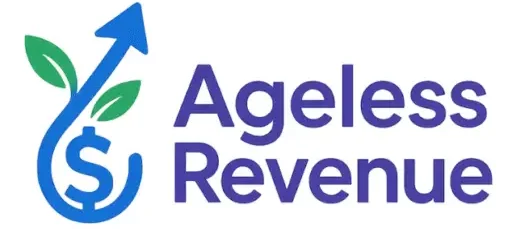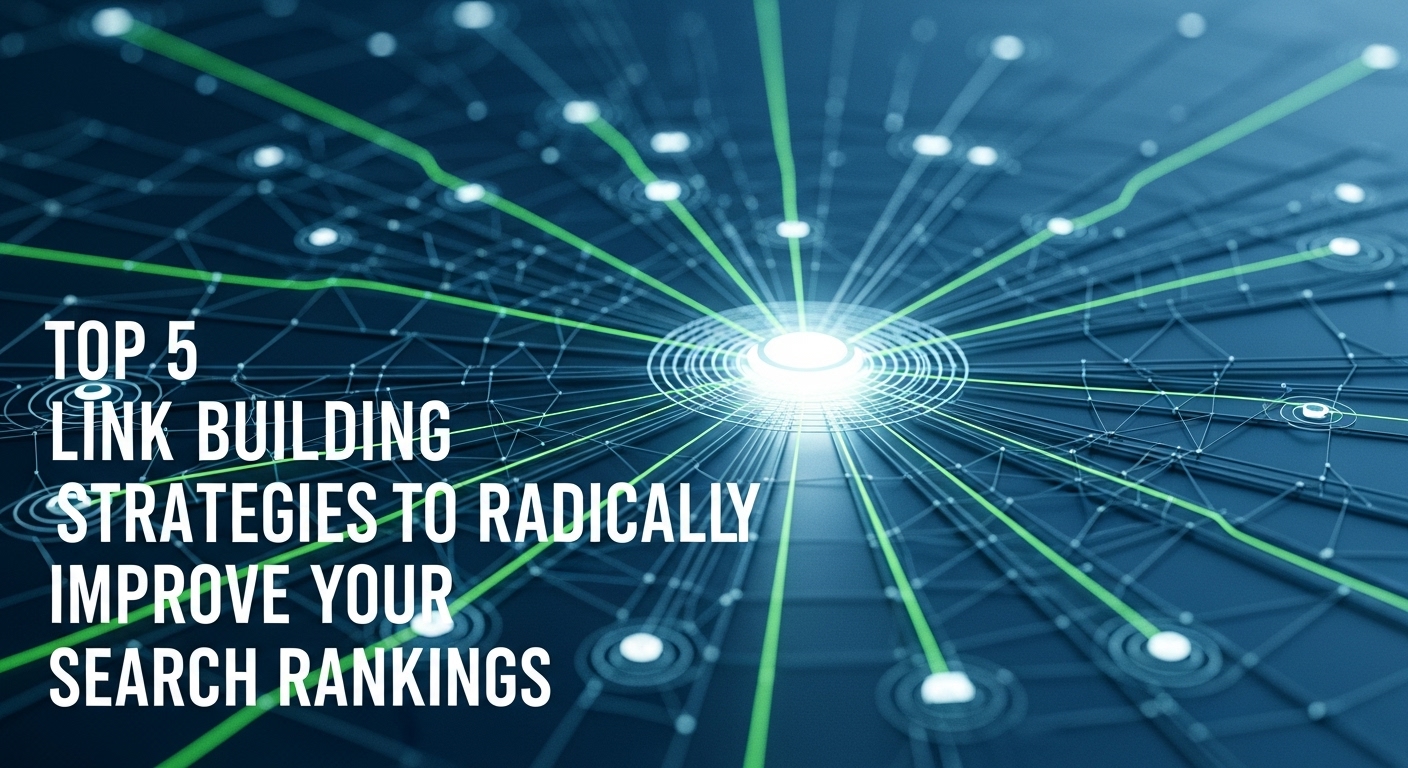Link building isn’t just a piece of the SEO puzzle; it’s the major structural player in the digital marketing game. Think of it as constructing highly credible digital bridges from other authoritative websites back to your own. These bridges serve two crucial purposes: they direct relevant traffic and, more importantly, they act as powerful votes of confidence in the eyes of search engine algorithms, boosting your site’s overall trustworthiness and search visibility.
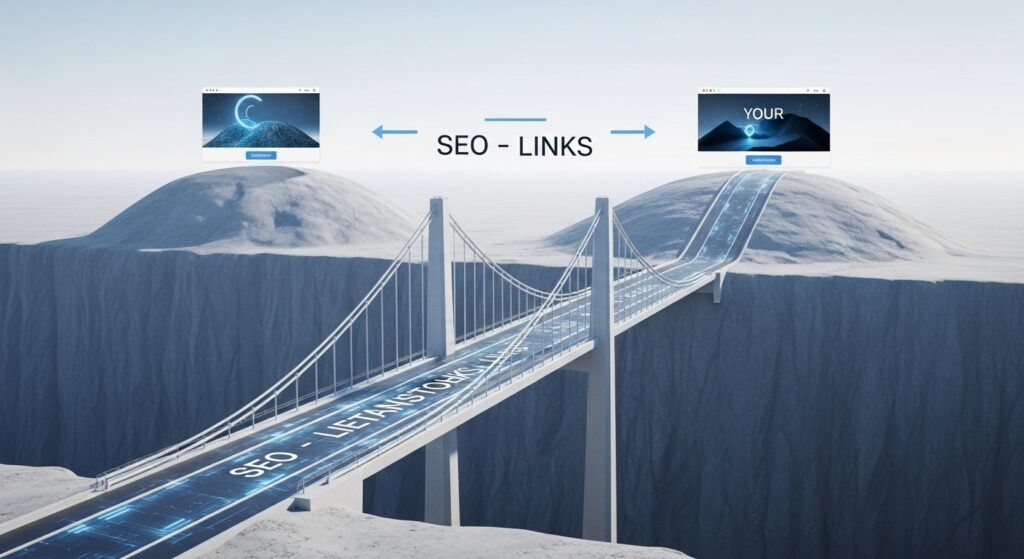
When reputable sites link to yours, it signals to search engines like Google that your content is valuable, reliable, and worth promoting to users. This process is fundamentally about establishing digital authority. The equation is simple yet profound: better, more relevant links equal substantially better search rankings and sustained organic traffic growth.
The Foundation: Links as Digital Trust Signals
For decades, links have remained one of the most heavily weighted ranking factors. In the modern era of Google’s algorithms, the focus has shifted entirely from link quantity to link quality, relevance, and context. The foundation of effective link building rests on the four established pillars of SEO:
- Content: The valuable asset you create that earns the link.
- Technical SEO: The website structure that allows search engines to find and value the link.
- On-Page Optimization: The context (anchor text, surrounding text) that defines the link’s topic.
- Off-Page Factors (Link Building): The process of acquiring these external votes of confidence.
Understanding this synergy is paramount. A great link pointing to a slow, unoptimized page, or to poor content, will have limited effect. Conversely, outstanding content on a technically sound site, backed by quality backlinks, creates a robust framework that supports all your SEO efforts and drives compounding results.
Essentials of a High-Impact Link Building Strategy
A successful link building campaign goes beyond tactical execution; it requires a strategic mindset focused on relevance, authority, and authenticity.
Quality Over Quantity: The Modern Mantra
The old days of mass link acquisition from directories or low-quality farms are over. Such practices often result in search engine penalties (a “Google Slap”). Today, a single, editorially earned link from a high-authority site like a major industry publication, a respected university, or a leading news organization can outweigh hundreds of low-quality links.
The core value of a backlink is now evaluated based on several criteria:
- Domain Authority (DA) / Domain Rating (DR): The overall strength and reputation of the linking site.
- Relevance: The topical connection between the linking page, the linking domain, and your target page. A link from an industry-specific blog is far more valuable than one from a general, unrelated site.
- Context: The link should be editorially placed within the body of the content, surrounded by relevant text (the anchor text).
- Trustworthiness (E-E-A-T): The most critical factor. The linking site must demonstrate Experience, Expertise, Authoritativeness, and Trustworthiness.
The Crucial Role of E-E-A-T in Link Building
Google’s E-E-A-T (Experience, Expertise, Authoritativeness, and Trustworthiness) framework is the guiding philosophy for quality raters and the algorithms that interpret link value.
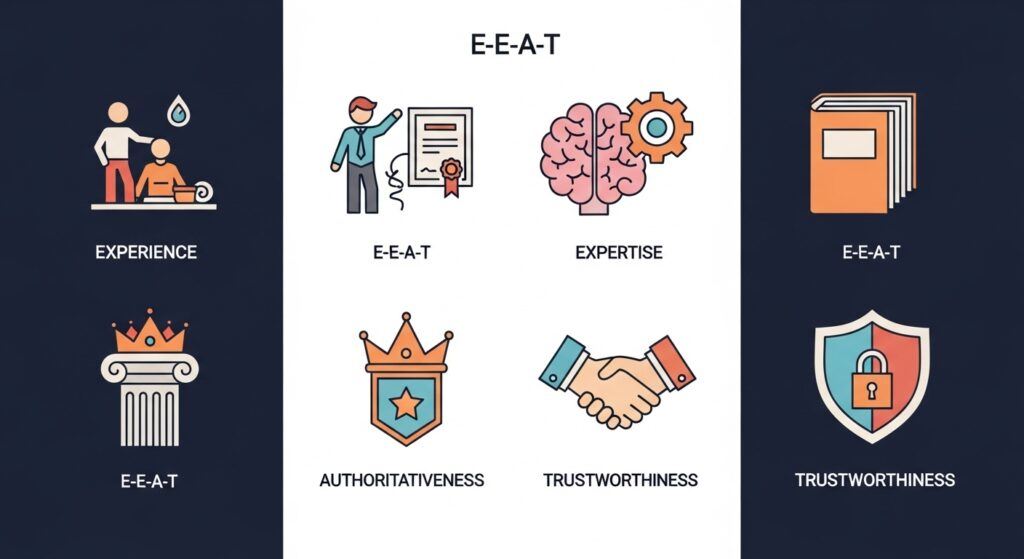
- Experience & Expertise: When a site run by a recognized subject matter expert links to your content, it validates your expertise in the field. This is why links from academic papers, industry-leading consultants, or proven practitioners carry immense weight.
- Authoritativeness: This is directly signaled by the quantity and quality of high-authority links pointing to the linking site itself. By earning a link from them, you are borrowing a portion of their authority.
- Trustworthiness: This is often the most important factor. Links from sites with clear author bios, verified facts, secure connections (HTTPS), and transparent editorial processes signal trust. If you are in a Your Money or Your Life (YMYL) niche (finance, health, safety), links from highly trustworthy, authoritative sources are non-negotiable for ranking success.
Actionable Insight: Your link building strategy must prioritize sites that clearly demonstrate strong E-E-A-T in their niche.
The Top 5 Link Building Strategies for Enhanced Website Search Rankings
Nailing your link-building game requires a clear focus on scalable, ethical strategies that align with Google’s quality guidelines. Here is a deep dive into the top five most effective techniques:
1. Content Creation & Digital PR: Earning Links Organically
This is the gold standard of link building. The strategy is to create “Linkable Assets”—content so unique, valuable, or data-rich that other sites naturally want to link to it to support their own claims or provide resources to their audience.
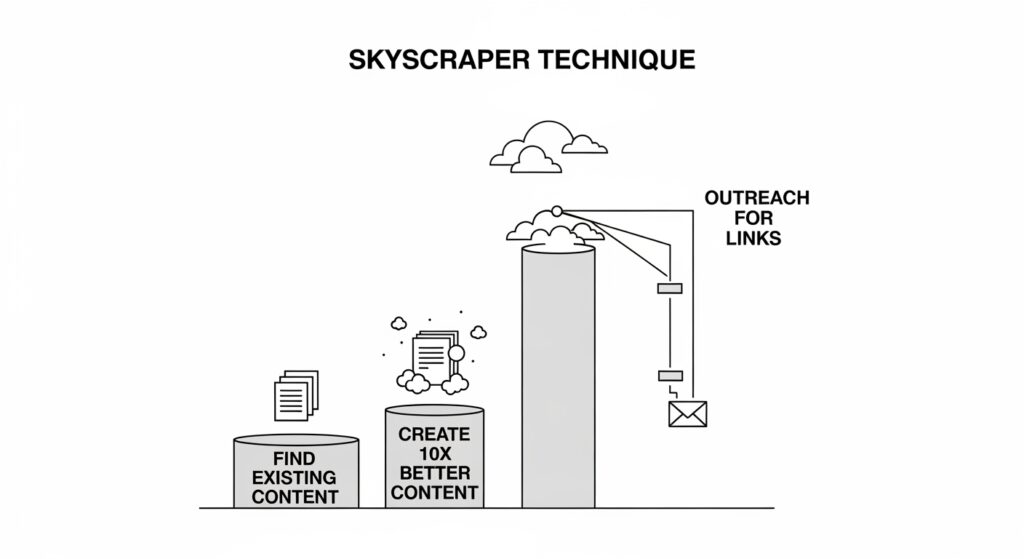
The Skyscraper Technique
The “Skyscraper Technique,” popularized by Brian Dean, is a systematic approach to this:
- Find Link-Worthy Content: Identify content in your niche that has already acquired many backlinks.
- Create 10x Content: Create a resource that is 10 times better than the best-ranking competitor. Make it more comprehensive, more up-to-date, better designed, and enriched with original data.
- Targeted Outreach: Reach out to the site owners who linked to the original, inferior content, politely suggesting they link to your superior, updated version instead.
Digital PR
Beyond simply creating content, Digital PR involves promoting your asset to journalists, bloggers, and industry curators. This is often focused on proprietary data, groundbreaking research, or interactive tools. When a major news outlet or industry blog features your original study, the resulting link is exponentially more valuable than one acquired through simple outreach.
- Key Asset Examples: Original industry reports, large-scale consumer surveys, interactive calculators, definitive “Ultimate Guides” (2,500+ words).
2. Strategic Guest Blogging (The New Standard)
Guest blogging remains a timeless classic, but its quality standards have become incredibly stringent. This is no longer about mass-submitting low-quality articles to any site that will accept them; it is about establishing yourself as a thought leader on a select few, high-authority platforms.
- Focus on Relevance: Only guest post on sites that are highly relevant to your niche, ensuring the audience is a perfect match for your expertise.
- Add Unique Value: The content you submit must be unique, non-promotional, and offer real value to the host site’s audience. It should demonstrate your E-E-A-T.
- Natural Link Placement: The link back to your site should be placed naturally and contextually within the body of the article, usually pointing to a related, deep resource page (not just your homepage).
- The Payoff: Guest blogging expands your brand reach, validates your expertise, and secures a powerful, editorially controlled backlink.
3. Broken Link Building (A Win-Win Strategy)
Broken link building is a savvy, technical, yet highly ethical strategy that leverages the concept of reciprocity.
- Identify Broken Links: Use SEO tools (Ahrefs, SEMrush) or browser extensions (Check My Links) to scan high-authority websites in your niche for 404 errors (broken outbound links).
- Create Replacement Content: If you have content on your site that is a suitable or better replacement for the broken page, identify it. If you don’t, create a new asset specifically for the opportunity.
- Perform Outreach: Send a friendly, personalized email to the site editor or owner, informing them of the broken link. Crucially, you then offer your superior piece of content as a seamless replacement, positioning yourself as a helpful resource.
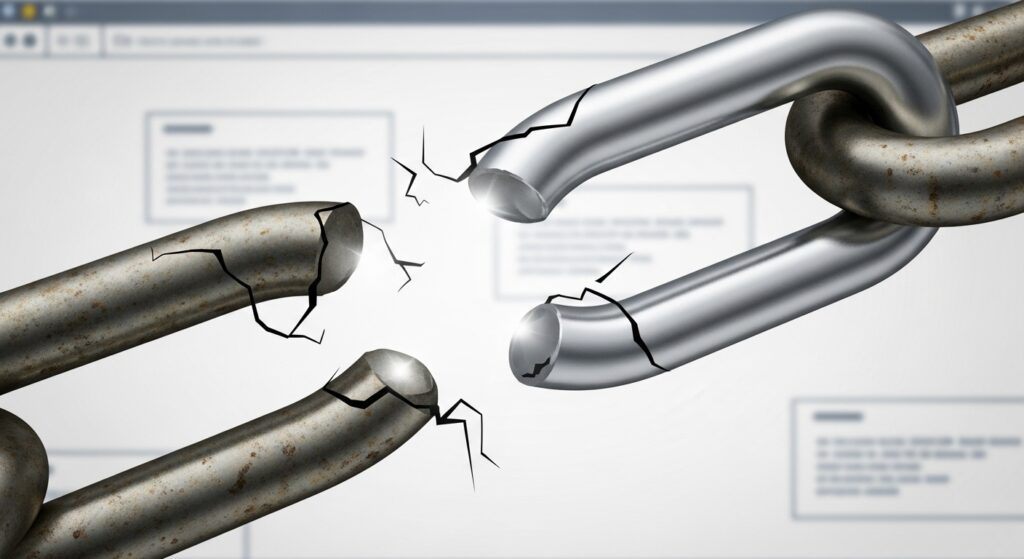
This strategy is highly favored because you are genuinely helping a site fix a technical error that harms their user experience, resulting in a high conversion rate for backlink acquisition.
4. Resource Page Link Building and Unlinked Mentions
This strategy involves targeting specific pages that are designed to curate and organize valuable links for a specific audience.
Resource Page Link Building
Many authoritative sites maintain “Resources,” “Tools,” “Recommended Reading,” or “Ultimate Guide” pages.
- Find the Pages: Search Google for phrases like:
[Your Niche] + "resources"[Your Niche] + "inurl:links""helpful links" + [Your Niche]
- Pitch Your Asset: If your content offers a genuinely useful resource (e.g., a free calculator, a definitive guide, a comprehensive list), reach out to the curator and politely suggest your page be added to their list. Focus on how your link will improve their page for their users.
Unlinked Brand Mentions (Link Reclamation)
Often, journalists, bloggers, or podcasters will mention your brand, product, or a unique piece of data from your site without including a link. This is the easiest type of link to “reclaim.”
- Monitor Mentions: Use tools like Google Alerts or Mention to track new mentions of your brand name.
- Outreach: Contact the author or editor, thank them for the mention, and simply ask if they would mind converting the brand mention into a clickable hyperlink to the relevant page on your site. This is a very high-conversion tactic as they have already signaled their trust and intention to use your brand.
5. Leveraging Influencers and Expert Roundups (Ego Bait)
This strategy leans into the human desire for recognition and leverages the power of social networks to attract links.
Influencer/Expert Roundups
Create a high-quality piece of content that directly features or quotes multiple influential people in your industry.
- Curate Content: Write an article like “20 Industry Experts Predict the Future of [Your Niche].”
- Outreach: Send a personalized email to each expert who was featured, notifying them that they have been cited in your new piece of content.
- The Result: The featured experts are highly likely to share the article with their network, mention it on social media, or, most importantly, link to it from their own blog’s “As Seen In” section or a resource page, dramatically multiplying the reach and link authority.
Collaboration and Partnerships
Identify companies or individuals in complementary, non-competing niches. A software company, for example, might partner with a consulting firm.
- Co-Create Content: Develop a webinar, a joint research paper, or a shared case study.
- Mutual Benefit: Both parties agree to link to the co-created asset, not only securing a link but also accessing a new, highly relevant audience. This is a robust, relationship-based strategy that builds trust signals.
Advanced Link Building Techniques for a Competitive Edge
Once the foundational strategies are mastered, these advanced tactics provide the competitive advantage necessary to dominate highly contested search results.
A. Reverse Engineering Competitor Backlinks
The most efficient way to find high-quality link opportunities is to see where your top-ranking competitors are getting theirs.
- Competitor Analysis: Use SEO tools to audit the backlink profiles of the top 3–5 websites ranking for your target keywords.
- Identify Gaps: Look for domains that link to your competitors but not yet to your site. These represent proven, high-converting opportunities.
- Superior Pitch: Analyze why they linked to the competitor. Was it a mention in a roundup? A quote in a guest post? Create a superior piece of content or a more compelling pitch to encourage them to link to you as well.
B. Link Reclamation from Content Migration
Websites are often restructured, or content is moved, leading to link loss.
- 404 Monitoring: Regularly monitor your site for pages returning a 404 error that still have incoming backlinks.
- Implement 301 Redirects: Immediately set up a 301 (Permanent) Redirect from the old, broken URL to the most relevant new page on your site. This ensures that the ‘link juice’ (authority) from the incoming link is fully preserved and passed to the new page, reclaiming lost value.
C. Leveraging HARO (Help A Reporter Out) and Expert Platforms
HARO is a platform that connects journalists working on stories with expert sources.
- Monitor Queries: Sign up to receive email queries from journalists seeking expertise in your niche.
- Provide High-Value Answers: Respond quickly with a concise, authoritative quote that answers their question. Be sure to include your name, title, and a link to your site for citation.
- E-E-A-T Payoff: Successful pitches often result in a mention and a powerful backlink from a major news, finance, or lifestyle publication, directly reinforcing your site’s E-E-A-T score.
Sustaining SEO Success Through Ethical Link Building
Achieving high search rankings is an ongoing commitment, not a one-time event. Sustained SEO success hinges on maintaining an ethical, user-centric, and dynamic link building strategy.
The White Hat Imperative
Ethical, “White Hat” link building means adhering strictly to Google’s Webmaster Guidelines. This is non-negotiable for long-term survival.
- Avoid Link Schemes: Never buy links, trade links excessively, use automated link programs, or participate in private blog networks (PBNs). These are “Black Hat” tactics that Google actively hunts for and penalizes with harsh manual actions.
- Focus on Relationships: Treat link building as relationship building. Genuine, mutually beneficial partnerships with other site owners, editors, and journalists are the foundation of a penalty-proof link profile.
- Diversify Anchor Text: Do not over-optimize anchor text. A natural link profile includes a diverse range of anchor texts:
- Branded: “According to [Your Brand Name]…”
- Naked URL: “Learn more at
yourwebsite.com/page“ - Generic: “click here,” “this article,” “read more”
- Partial Match: “best link building strategies for 2025″ (using a keyword phrase).
Tools and Analytics for Perpetual Improvement
The right toolkit is essential for scalability and efficiency.
| Tool Category | Tool Examples | Core Function in Link Building |
| Backlink Analysis | Ahrefs, SEMrush, Moz Pro | Reverse-engineer competitor links, audit your own profile, find broken links. |
| Outreach | BuzzStream, Hunter.io, Pitchbox | Streamline contact finding, personalize outreach emails, manage campaign follow-ups. |
| Unlinked Mentions | Google Alerts, BrandMentions | Track real-time mentions of your brand across the web for link reclamation. |
| Quality Assessment | Moz Domain Authority (DA), Ahrefs Domain Rating (DR) | Quantify the authority of prospective linking sites. |
By regularly reviewing your link acquisition velocity, the authority of your linking domains, and the resulting change in keyword rankings, you can continually refine your strategy, ensuring your efforts remain focused on the highest-ROI activities.
Conclusion: The Long-Term Vision for Authority
Link building is the engine of sustained organic growth and digital authority. In the ever-evolving landscape of search, the underlying principle remains constant: Google rewards sites that are trusted, recommended, and genuinely useful.
The five core strategies—Content Creation/Digital PR, Strategic Guest Blogging, Broken Link Building, Resource Page Outreach, and Influencer/Expert Roundups—provide a comprehensive and ethical framework for building a robust backlink profile. By integrating these tactics with the principles of E-E-A-T, you move beyond merely acquiring links and begin actively building your brand’s reputation.
Commit to quality over quantity, prioritize relationships over transactions, and maintain a relentless focus on creating 10x content. This is the only path to not just temporarily improve, but to radically and sustainably elevate your search rankings and solidify your position as an authoritative leader in your industry.
❓ Frequently Asked Questions (FAQ)
Q1: What is the difference between a “Dofollow” and a “Nofollow” link?
A:
- Dofollow (Default): This type of link is the standard and passes “link juice” or authority from the linking site to your site. This is the primary goal of most link building.
- Nofollow (
rel="nofollow"): This attribute tells search engines not to pass authority to the linked page. While it doesn’t directly help rankings, it can still drive referral traffic and is important for a natural, diverse link profile.
Google has introduced additional attributes:
rel="sponsored": Used for links created as part of advertisements, sponsorships, or other compensation agreements.rel="ugc"(User-Generated Content): Used for links within comments and forum posts.
Google treats nofollow, sponsored, and ugc as hints rather than strict directives, but “dofollow” links from authoritative sources are what move the ranking needle most effectively.
Q2: How long does it take for a new backlink to impact my search rankings?
A: The impact time varies significantly based on the authority of the linking site and the competitive difficulty of the target keyword.
- High-Authority Link (DR 70+): You may see a positive change in rankings and organic traffic within 1 to 6 weeks.
- Lower-Authority Link (DR 30-50): The impact might take 2 to 4 months to register, and the effect will be less pronounced.
- Overall Strategy: It takes consistent effort over 6 to 12 months to build a profile robust enough to compete for highly competitive keywords. SEO is a marathon, not a sprint.
Q3: Is buying backlinks always a bad idea?
A: Yes, buying links specifically for the purpose of passing authority (PageRank) is a violation of Google’s Webmaster Guidelines and is considered a Black Hat technique.
- Risk: If caught (and Google is very good at detection), your site can incur a severe Manual Penalty, resulting in a catastrophic drop in search rankings that is difficult to recover from.
- Legitimate Purchases: You can pay for advertising or sponsorships, but those links must use the
rel="sponsored"attribute to indicate that payment was exchanged, thereby preventing the transfer of SEO authority.
Q4: Should I worry about my competitors building bad links to my site (Negative SEO)?
A: While less common than in the past, Negative SEO (where a competitor points thousands of spammy links at your site) is a legitimate concern in highly competitive niches.
- Mitigation: You should regularly audit your backlink profile for large spikes in low-quality or irrelevant links.
- Action: If you find a pattern of toxic links, you can use the Google Disavow Tool to tell Google to ignore those specific links, protecting your site from potential penalties.
Q5: What is the ideal anchor text strategy?
A: The ideal strategy is a natural and diverse distribution. Avoid using the same keyword (exact-match anchor text) for every link, as this looks manipulative to Google’s algorithms.
A healthy anchor text ratio generally looks like this:
- Branded/Naked URL/Generic: 60-70%
- Partial Match/Long-tail Keyword: 20-30%
- Exact Match Keyword: 1-5% (Used very sparingly and only from highly relevant, authoritative sources).
